In today’s digital age, most of us have embraced the convenience of online shopping through giants like Amazon or peer-to-peer platforms like eBay. While the surface gleams with product images, swift transactions, and one-click purchases, have you ever wondered about the backbone that keeps these platforms glitch-free? Enter e-commerce testing. This unsung hero ensures that every digital cart addition, product search, and payment gateway works seamlessly, guaranteeing a smooth shopping experience. From the widely known Business-to-Consumer (B2C) model to the rising trend of mobile commerce, e-commerce testing ensures every touchpoint functions flawlessly. So, the next time you effortlessly browse through an online store or quickly check out, remember there’s a whole world of e-commerce testing working tirelessly behind the scenes, making it all possible. Dive in with us as we unravel the intricacies of e-commerce and the pivotal role of testing in this digital marketplace.
What Is E-commerce?
“E-commerce,” often called “e-commerce,” is electronic commerce. E-commerce involves purchasing and selling products or services online, accompanied by the digital exchange of money and information to complete these deals.
Advancements in digital payment methods, search engine optimization, online advertising, and the proliferation of web technologies have all contributed to the rapid growth of e-commerce worldwide. E-commerce also offers several benefits over traditional brick-and-mortar stores, such as a broader customer base, availability 24/7, and often a wider variety of products or services. However, it also comes with challenges such as cybersecurity threats, intense competition, and ensuring seamless user experiences.
E-commerce Business Types
E-commerce has evolved over the years and can now be classified into several sub-categories:
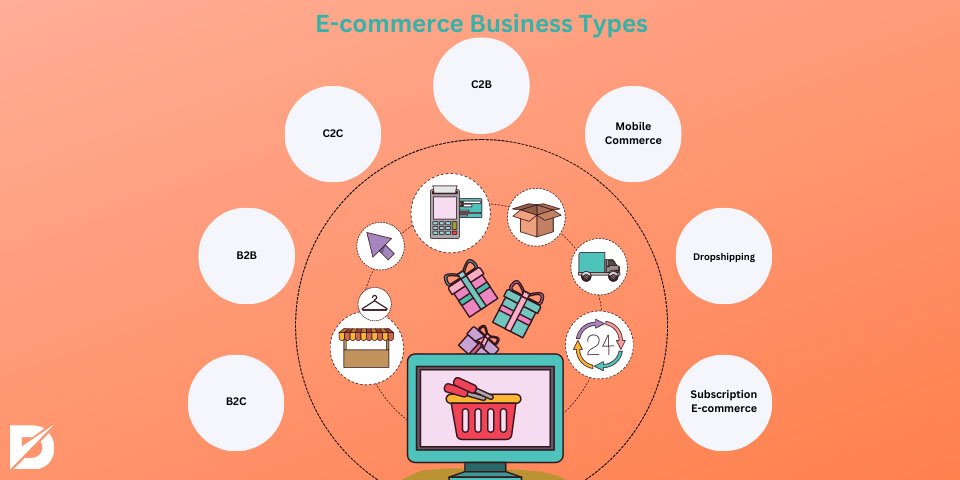
- B2C (Business-to-Consumer): This is the most common form where businesses sell to the general public, typically through catalogs utilizing shopping cart software. Examples include online retailers like Amazon, Walmart’s online store, and other similar platforms.
- B2B (Business-to-Business): Here, businesses sell to other businesses. This could be in the form of wholesale products, software solutions, or other services.
- C2C (Consumer-to-Consumer): Platforms like eBay and Craigslist facilitate this type of e-commerce, where consumers can sell directly to other consumers.
- C2B (Consumer-to-Business): In this model, consumers offer their services or products to a company. For example, a freelancer platform where businesses can hire individual freelancers for tasks.
- Mobile Commerce: With the increase in smartphone usage, shopping on mobile devices (often via mobile apps) has become a significant e-commerce segment.
- Dropshipping: This retail approach involves a store not holding the products it offers in inventory. Rather, when a product is sold, the store procures it from a third party, who then ships it directly to the consumer.
- Subscription E-commerce: This model is based on recurring sales. Businesses provide products or services regularly (like monthly or quarterly) in exchange for regular payments. Examples include subscription boxes for beauty products, food, or magazines.
What Is an E-commerce Site?
An “e-commerce site” is a website that facilitates the buying and selling of goods and services over the Internet. These sites handle various functions required for online sales, including product listings, shopping carts, checkout processes, payment processing, and order management.
Here are some key features and characteristics of e-commerce sites:
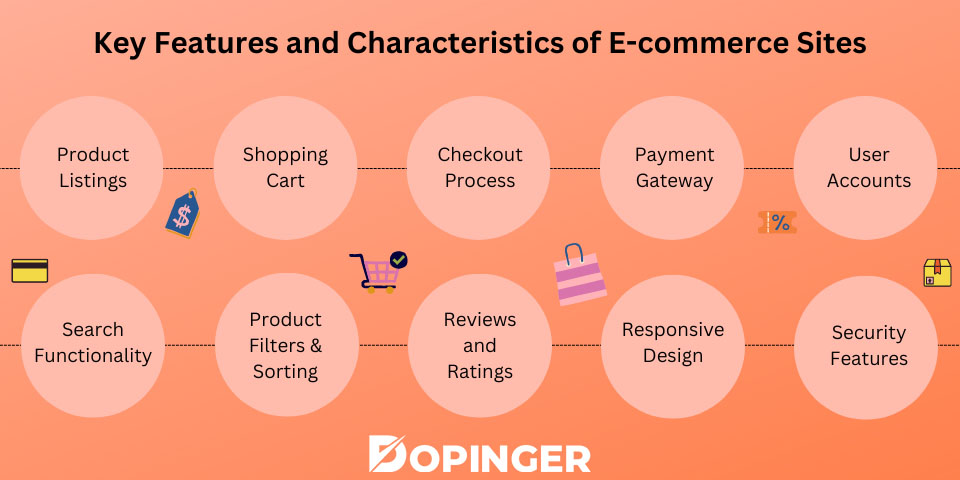
- Product Listings: Display information about products or services, including images, descriptions, prices, and specifications.
- Shopping Cart: Allows users to collect and manage products they intend to purchase.
- Checkout Process: A series of pages or steps that gather necessary information from the buyer, such as shipping address and payment details.
- Payment Gateway: Integrates with financial systems to securely handle payment transactions. Common payment gateways include PayPal, Stripe, and Square.
- User Accounts: Customers can register, log in, and manage their profiles, order history, and preferences.
- Search Functionality: Helps users find products or services quickly.
- Product Filters & Sorting: Allow users to narrow down products based on certain criteria or sort products by relevance, price, popularity, etc.
- Reviews and Ratings: Let customers share their experiences and feedback about products.
- Responsive Design: Ensures the site is accessible and usable on various devices, especially mobile phones and tablets.
- Security Features: Essential for protecting customer data and ensuring trust. This includes SSL certificates, secure login processes, and other safety measures.
Examples of e-commerce sites range from large global retailers like Amazon and Alibaba to smaller, niche online stores. Some businesses also use platforms like Shopify, WooCommerce (for WordPress), and Magento to set up and manage their e-commerce websites, making the process more straightforward without needing extensive technical expertise.
What Is E-commerce Testing?
E-commerce testing refers to rigorously testing e-commerce websites or applications to ensure that they function correctly, are user-friendly, and offer a seamless shopping experience to users. Given the financial nature of transactions and users’ expectations for a hassle-free shopping experience, thorough testing is crucial for e-commerce platforms.
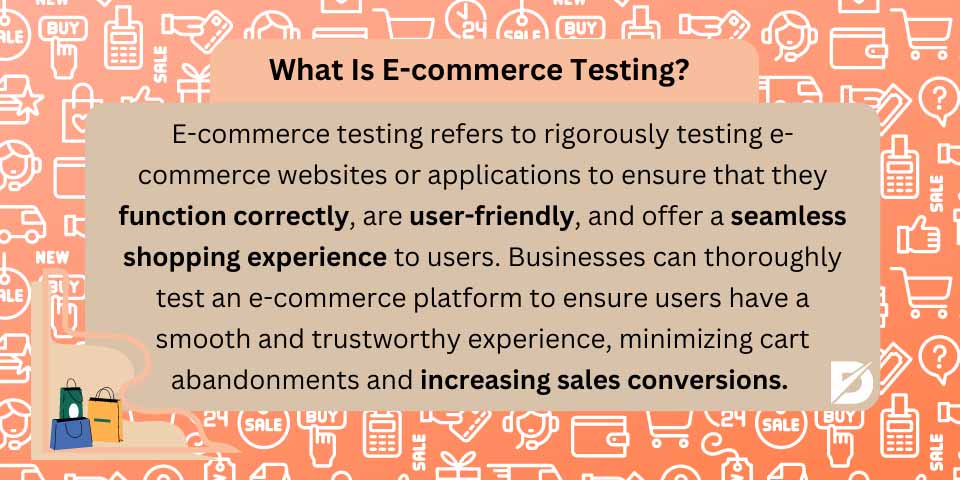
Businesses can thoroughly test an e-commerce platform to ensure users have a smooth and trustworthy experience, minimizing cart abandonments and increasing sales conversions. Given the potential revenue impact and brand reputation concerns, e-commerce testing is critical to launching or maintaining an online shopping platform.
How Do You Do E-commerce Testing?
Performing e-commerce testing requires a systematic approach to ensure all aspects of the site or application are covered. Here’s a step-by-step guide to conducting effective e-commerce testing:
Requirement Gathering
- Understand the complete functionality of the e-commerce site.
- Gather requirements from stakeholders, product managers, and designers.
Test Planning
- Outline the scope of testing.
- Identify the tools required for testing.
- Allocate resources and define timelines.
- Set up a test environment that mimics the production environment.
Test Case Design
- Create test cases based on functionalities. For instance:
- Testing product addition to the cart.
- Testing the checkout process.
- Testing payment gateway integration.
- Ensure test cases cover positive (expected behavior) and negative scenarios (error conditions).
Functionality Testing
- Test the core functionalities such as product search, cart addition/removal, user registration/login, and checkout process.
- Ensure all links, filters, sorting functions, etc., work as expected.
Usability Testing
- Evaluate the user interface for intuitiveness and ease of navigation.
- Test on different devices to ensure consistent user experience.
Performance Testing
- Use tools like JMeter or LoadRunner.
- Conduct load testing to simulate multiple users accessing the site simultaneously.
- Perform stress testing to identify the system’s breaking point.
- Evaluate the site’s response time.
Security Testing
- Check for vulnerabilities like SQL injections, cross-site scripting, etc.
- Ensure SSL certificates are correctly implemented.
- Test the security of payment gateways and data encryption.
Compatibility Testing
- Test the site on different browsers (Chrome, Firefox, Safari, Edge).
- Ensure the site is responsive on various devices and screen resolutions.
Database Testing
- Check data integrity and consistency.
- Ensure smooth data retrieval and storage processes during transactions.
Payment Gateway Testing
- Test various payment methods like credit/debit cards, e-wallets, etc.
- Ensure transactions are smooth and secure.
- Simulate scenarios like payment failures and ensure the site handles them gracefully.
Recovery and Backup Testing
- Simulate server crashes or unexpected shutdowns and check how the system recovers.
- Test backup systems to ensure data is not lost.
Regression Testing
- After every major update or bug fix, test the system to ensure new changes haven’t introduced new issues.
Review and Reporting
- Document test results and share them with stakeholders.
- Highlight any critical issues or areas of concern.
Bug Tracking and Resolution
- Use tools like JIRA or Bugzilla to track and manage identified issues.
- Ensure developers address critical issues promptly.
Repeat Testing (if necessary)
- After developers fix issues, repeat the relevant tests to confirm the solutions are effective.
Final Review
- Once all tests are passed, conduct a final review with stakeholders before moving the site to production.
Remember, while this process provides a comprehensive approach, the specifics of e-commerce testing will depend on the individual platform, its features, and its target audience. Adjust the testing process according to the unique needs of each project.
Before Performing E-commerce Testing
Before running an e-commerce test, it’s crucial to have a clear understanding of several key aspects to ensure the test’s success and reliability. Here are some considerations to keep in mind:
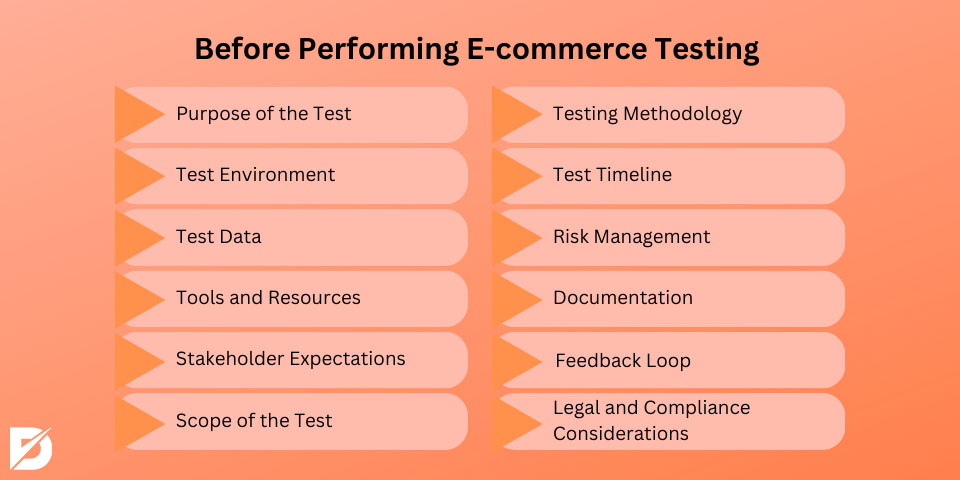
Purpose of the Test
- What specific aspect of the e-commerce platform are you testing? It might be usability, performance, security, etc.
- Understand what you’re trying to achieve: uncovering bugs, improving user experience, or ensuring the system can handle high traffic.
Test Environment
- Set up a test environment that closely mirrors the production environment. This ensures that your tests reflect real-world scenarios.
- Ensure the test environment is isolated from the production environment to avoid unintended disruptions or data corruption.
Test Data
- For effective testing, you’ll need realistic test data. This includes user profiles, product details, transaction records, etc.
- Avoid using real customer data for testing due to privacy concerns. Instead, use anonymized or synthetic data.
Tools and Resources
- Identify the tools you’ll use for testing, such as Selenium for automation testing, JMeter for performance testing, or OWASP ZAP for security testing.
- Ensure you have access to necessary devices and browsers for compatibility testing.
Stakeholder Expectations
- Engage with stakeholders (e.g., product managers, developers, business teams) to understand their expectations and concerns.
- Clearly define the success criteria for the test.
Scope of the Test
- Clearly outline which parts of the e-commerce platform will be tested and which will not.
- Prioritize critical functionalities, like the checkout process or payment gateway integration.
Testing Methodology
- Decide whether you’ll use manual testing, automated testing, or a combination of both.
- Determine the types of tests to run: functional, usability, performance, security, etc.
Test Timeline
- Plan the testing schedule. Determine when the tests will start, the expected duration, and when results will be available.
- Schedule tests during times that minimize disruption, especially if load or stress testing.
Risk Management
- Anticipate potential issues or challenges that might arise during testing.
- Have a contingency plan if critical issues are uncovered or the testing affects other systems.
Documentation
- Ensure you have templates or systems to document test cases, test results, and any identified issues.
- Documentation will be vital for reviews, debugging, and future reference.
Feedback Loop
- Establish a clear communication channel with developers or the technical team to address issues as they arise.
- This helps in quick resolution and iterative testing if required.
Legal and Compliance Considerations
- This is especially relevant for payment gateway testing and user data handling.
- Ensure all tests comply with regulations and do not jeopardize customer data.
By having clarity on these aspects, you can ensure that your e-commerce testing is thorough and aligned with the platform’s business objectives and technical requirements. Proper preparation will lead to more accurate results, better insights, and a more reliable and successful e-commerce platform.
Why Is It Important to Do E-commerce Testing?
E-commerce testing is vital for several reasons. Here are the primary reasons why testing is crucial for e-commerce platforms:
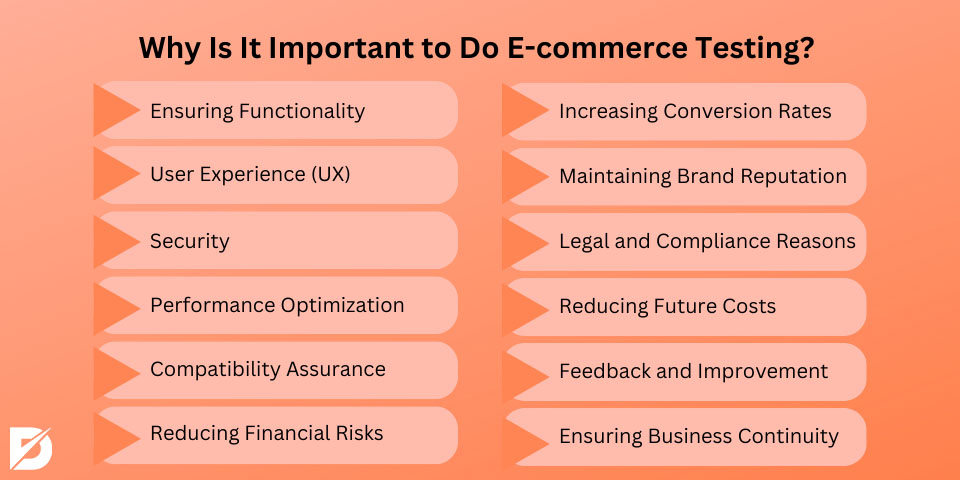
- Ensuring Functionality: E-commerce platforms have various functionalities, such as product searches, shopping carts, payment gateways, etc. Testing ensures that these features work seamlessly and without errors.
- User Experience (UX): A positive UX is crucial for customer retention and conversion. Testing identifies bottlenecks, navigation issues, and other hindrances.
- Security: E-commerce sites handle sensitive customer information, including addresses, payment details, and personal data. Ensuring this data is protected from breaches and vulnerabilities is essential to maintain customer trust and compliance with data protection regulations.
- Performance Optimization: During peak sales or promotional events, e-commerce sites can experience significant traffic. Performance testing ensures the platform can handle such loads without crashing or slowing down.
- Compatibility Assurance: Users access e-commerce sites from various devices and browsers. Compatibility testing ensures the site looks and functions correctly.
- Reducing Financial Risks: Mistakes or errors in the checkout or payment process can lead to financial losses or discrepancies. Testing ensures transactions are processed correctly.
- Increasing Conversion Rates: If customers encounter issues while purchasing, they may abandon their carts. Testing reduces such glitches, potentially improving e-commerce conversion rates.
- Maintaining Brand Reputation: A smoothly functioning and user-friendly e-commerce site enhances a brand’s reputation, while a glitchy site can lead to negative reviews and poor public perception.
- Legal and Compliance Reasons: Ensuring that payment gateways and data handling practices comply with regional and international regulations can prevent potential legal issues.
- Reducing Future Costs: Identifying and resolving issues early in the development process can be more cost-effective than fixing them after the platform has gone live.
- Feedback and Improvement: Regular testing, especially after updates or introducing new features, provides feedback that can guide future enhancements.
- Ensuring Business Continuity: A malfunctioning e-commerce site can disrupt sales.
Last Words
In summary, e-commerce testing is vital not only for the technical soundness of the platform but also for business profitability, customer trust, and overall market competitiveness. Considering the potential repercussions of a malfunctioning or insecure e-commerce site, regular testing becomes a pivotal activity for any online retailer.
Other Articles About E-commerce:
- Best eCommerce Platforms for Your Online Store
- How to Speed Up Your eCommerce Website
- Recent Trending Products
- How to Start an eCommerce Business
- How to Increase eCommerce Sales
Frequently Asked Questions About
E-commerce testing involves evaluating an e-commerce platform’s functionalities, security, performance, usability, and other aspects to ensure a seamless and trustworthy shopping experience for users.
They handle sensitive user information like credit card details, addresses, and more. Ensuring the security of these details is crucial to maintaining user trust, protecting from potential breaches, and complying with data protection regulations.
E-commerce platforms should be tested regularly, especially after every major update, feature addition, or change to the platform. Additionally, periodic security assessments, performance tests during expected high-traffic events (like sales), and routine usability checks are crucial for maintaining the platform’s integrity and user experience.
For automated functional testing, tools like Selenium and TestComplete are popular. For performance testing, JMeter and LoadRunner are commonly used. Security assessments might involve tools like OWASP ZAP or Burp Suite. The choice of tool often depends on the specific needs and technology stack of the e-commerce platform.
Testing payment gateways involves multiple steps. First, always use a sandbox or test environment provided by the payment gateway provider. Next, simulate various transaction scenarios, including successful payments, failed payments, partial payments, refunds, etc. Also, ensure the platform handles transaction errors gracefully, providing appropriate messages to users. Regularly update and test integrations as payment gateways can evolve or change their APIs.




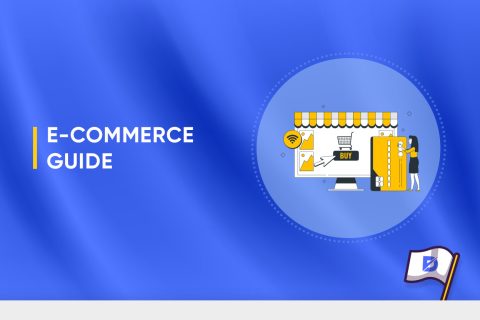
No comments to show.